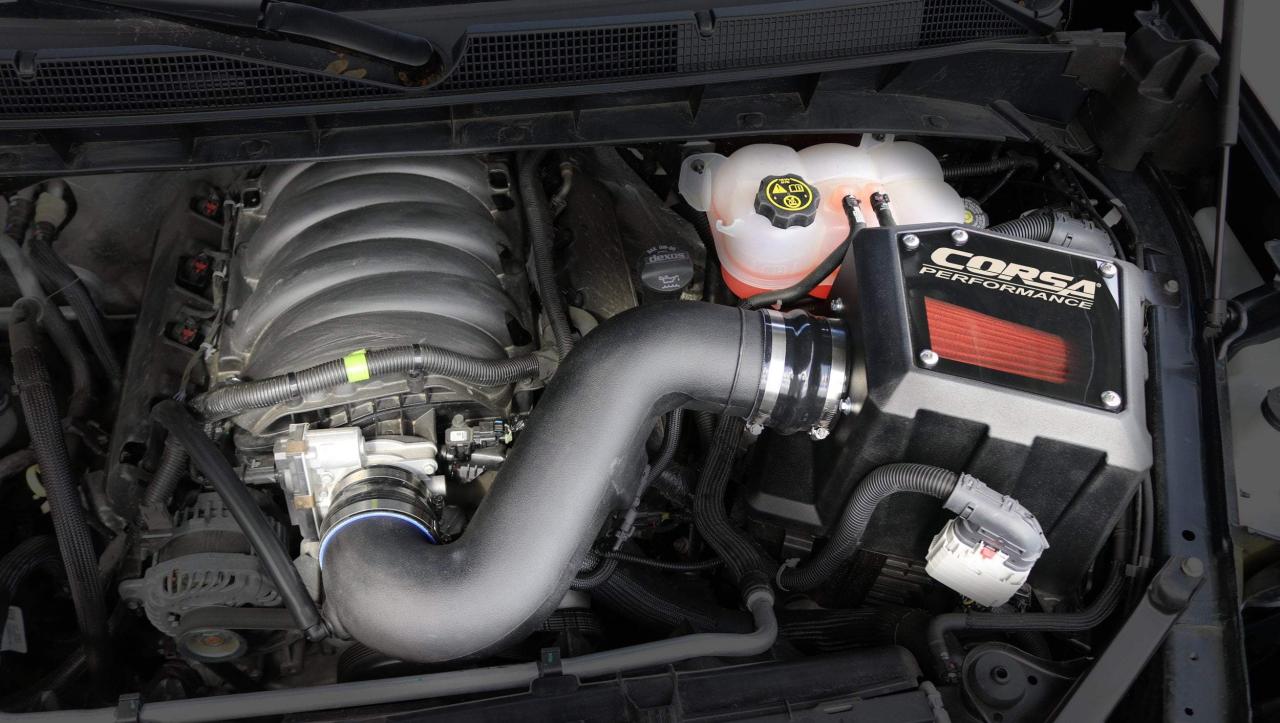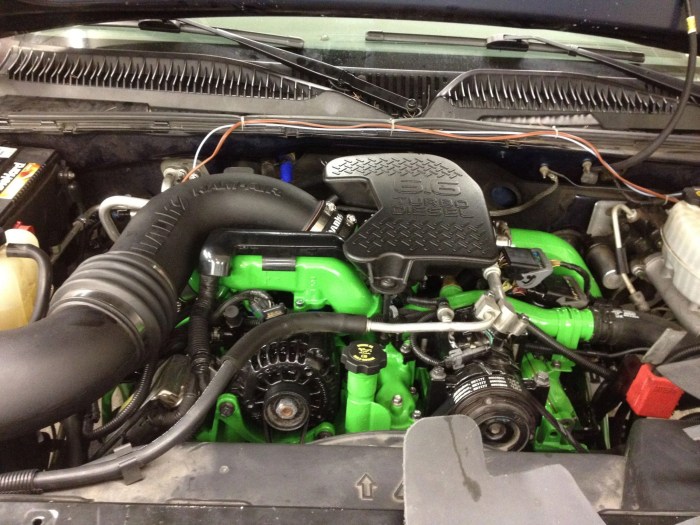Cold air intake upgrades for Chevy Silverado? Yeah, let’s talk about that. Seriously boosting your truck’s performance is totally doable, and a cold air intake is a great place to start. We’re diving into the different types – short ram, cold air, the whole shebang – exploring popular brands, and even tackling the installation process. Get ready to unleash some extra horsepower and maybe even improve your gas mileage.
This isn’t just about adding some shiny parts under the hood; we’ll cover the pros and cons of various systems, address potential warranty issues, and even give you some tips on maintenance. Think of this as your ultimate guide to squeezing every ounce of performance out of your Silverado.
Introduction to Cold Air Intake Upgrades
Upgrading your Chevy Silverado’s air intake system can significantly boost performance and potentially improve fuel economy. A cold air intake system replaces the restrictive factory air intake with a design that draws cooler, denser air into the engine. This cooler air allows for more complete combustion, leading to increased horsepower and torque. It’s a relatively straightforward modification that can yield noticeable results, making it a popular upgrade among Silverado owners.A cold air intake system works by improving the efficiency of the air-fuel mixture entering the engine.
The factory air intake often uses a less-than-ideal design, drawing warm air from the engine bay. This warm air is less dense, meaning less oxygen is available for combustion. A cold air intake system typically draws air from a cooler source, such as outside the engine bay, resulting in a denser air-fuel mixture. This denser mixture burns more efficiently, leading to increased power output and, in some cases, slightly improved fuel efficiency.
The gains are most noticeable at higher engine speeds and under heavy loads.
Types of Cold Air Intake Systems
Cold air intake systems are broadly categorized into a few main types, each with its own design and performance characteristics. The choice of system depends on factors like budget, desired performance gains, and installation complexity.
- Short Ram Intake: A short ram intake system replaces the factory airbox and piping with a shorter, less restrictive design. It often draws air from the engine bay, though sometimes with a heat shield to help insulate the intake from engine heat. Short ram intakes are generally less expensive and easier to install than full cold air intakes, but they may not offer the same performance gains because they still draw air from a relatively warm location.
So, you’re thinking about cold air intake upgrades for your Chevy Silverado? That’s awesome! Boosting performance is always a good time, but if you’re hauling the whole fam-bam around, maybe you should check out Top-rated full-size SUVs for families 2025 first. After all, a family-friendly ride might be a better investment than a souped-up truck if your priorities have shifted.
Then, once you’ve got the family hauler sorted, you can always get back to those Silverado cold air intakes.
A visual representation would show a shorter intake tube directly connected to the throttle body, often with a cone-shaped filter visible in the engine bay.
- Cold Air Intake: A cold air intake system is designed to draw air from a location outside of the engine bay, typically using a longer intake tube that routes air from a cooler, denser source. This results in more significant performance gains compared to a short ram intake. The added length and tubing can make installation more complex. Imagine a longer tube extending from the engine bay, potentially through a fender well or other area, to draw air from outside the vehicle.
A large, often cylindrical, air filter is typically visible.
- Performance Cold Air Intakes: These systems represent the top tier of cold air intake upgrades, often featuring advanced designs, materials, and filters. They might incorporate features like larger diameter tubing for reduced restriction, high-flow air filters for optimal airflow, and even heat shielding for improved air cooling. The increased cost reflects the higher performance potential and more sophisticated engineering. A picture might show a polished aluminum intake tube with a high-quality filter and strategically placed heat shielding.
Popular Cold Air Intake Brands for Chevy Silverado
Choosing the right cold air intake for your Chevy Silverado can significantly impact performance and sound. Many reputable brands offer various options, each with its own strengths and weaknesses. Consider factors like budget, desired performance gains, and ease of installation when making your selection. Let’s examine some popular choices.
Cold Air Intake Brand Comparison
The following table compares four popular cold air intake brands for the Chevy Silverado, considering price, features, and customer feedback. Keep in mind that prices can fluctuate based on retailer and specific model year compatibility. Customer reviews are generally positive across the board, but individual experiences may vary.
| Brand | Approximate Price Range | Key Features | Customer Review Summary |
|---|---|---|---|
| K&N | $250 – $400 | High-flow air filter, washable and reusable filter, improved horsepower and torque, dyno-tested performance gains, often includes heat shield | Generally positive; known for quality and longevity, but some users report slightly less dramatic performance gains than advertised. |
| aFe POWER | $300 – $500 | High-flow air filter, mandrel-bent tubing for optimal airflow, pro-5r oiled filter, potential for significant horsepower and torque gains, often includes heat shield | Positive reviews; praised for noticeable performance improvements and aggressive sound. Some report slightly more complex installation. |
| Injen Technology | $200 – $350 | High-flow air filter, lightweight design, often features a shorter intake tube for improved airflow, various color options available | Mostly positive; users appreciate the balance of performance and price. Some users report a less aggressive intake sound than other brands. |
| Banks Power | $400 – $600 | High-flow air filter, often includes a power programmer for enhanced performance, designed for increased horsepower and torque, may include additional features like air temperature sensors | Positive; noted for significant performance gains, but comes at a higher price point. Installation can be more involved due to additional components. |
K&N Cold Air Intake Installation
The K&N cold air intake installation process generally involves several steps. First, you’ll need to disconnect the factory air intake system. This usually entails removing clamps, hoses, and the airbox itself. Next, carefully position the K&N intake tube, ensuring proper alignment with the mass airflow sensor and throttle body. Secure the tube using the provided clamps.
Finally, install the K&N high-flow air filter and reconnect any necessary hoses or sensors. Consult the specific K&N installation instructions for your Chevy Silverado’s year and model for detailed diagrams and torque specifications. It’s crucial to follow these instructions carefully to avoid damaging components or voiding any warranties. While generally straightforward, some mechanical aptitude is helpful.
Properly torquing all the clamps is crucial for a secure and leak-free installation.
Performance Gains and Considerations

Upgrading your Chevy Silverado with a cold air intake promises performance enhancements, but it’s crucial to understand both the potential gains and the risks involved. The actual improvements you experience will depend on several factors, including the specific intake system, your truck’s modifications, and even your driving style. Let’s delve into the specifics of what you can expect.
While manufacturers often advertise significant horsepower and torque increases, real-world results can vary. The gains are typically modest, often in the range of 5-15 horsepower and a similar increase in torque. These gains are most noticeable in the mid-range RPMs, translating to improved throttle response and potentially slightly better acceleration. However, it’s important to temper expectations; a cold air intake alone won’t transform your Silverado into a race truck.
Factors such as engine tuning, exhaust system, and other modifications significantly influence overall performance. Moreover, the environmental conditions—temperature, altitude, and air density—also play a role in the actual performance gains observed.
Performance Gains from Different Cold Air Intake Systems
The magnitude of performance gains varies depending on the cold air intake system. Higher-end systems, often featuring larger diameter tubing, improved air filters, and optimized airflow pathways, generally yield slightly better results than budget-friendly options. However, the difference might be marginal, and the cost increase might not always justify the small performance bump. For example, a K&N Typhoon intake system might offer a slightly larger gain than a less expensive Spectre Performance system, but the difference might only be a few horsepower.
Thinking about cold air intake upgrades for your Chevy Silverado? That’s a great way to boost performance, but first, you might want to check out which trucks are actually worth upgrading. If you’re on a budget, scoping out the Most reliable used trucks under $20k 2025 list might be smart; then you can focus on those sweet cold air intake upgrades.
This small difference needs to be weighed against the price difference. Independent testing and reviews from reputable automotive sources should be consulted for accurate comparisons between specific systems.
Potential Negative Effects of Improper Installation or Unsuitable Systems
Improper installation or the use of an unsuitable cold air intake system can lead to several problems. A poorly installed system might result in leaks in the intake tract, leading to a loss of power and potentially damaging the engine. Using an intake system that isn’t designed for your specific Silverado model could also cause issues with fitment, airflow restrictions, or even interference with other components.
Furthermore, some less-expensive intakes might use lower-quality materials, potentially reducing their lifespan and affecting the overall performance and reliability. In extreme cases, using an improperly designed or installed cold air intake can lead to engine damage, requiring costly repairs.
Summary of Potential Gains and Issues
| Cold Air Intake System | Potential Horsepower Gain | Potential Torque Gain | Potential Issues |
|---|---|---|---|
| High-end (e.g., K&N Typhoon) | 5-15 hp | 5-15 lb-ft | High cost, potential fitment issues if not properly researched |
| Mid-range (e.g., AEM) | 3-10 hp | 3-10 lb-ft | Moderate cost, less noticeable gains than high-end systems |
| Budget-friendly (e.g., Spectre Performance) | 1-7 hp | 1-7 lb-ft | Potential for lower quality materials, reduced lifespan |
| Improper Installation (Any System) | 0 hp (or even loss of hp) | 0 lb-ft (or even loss of lb-ft) | Engine damage, loss of power, vacuum leaks |
Installation Guide and Best Practices

Installing a cold air intake on your Chevy Silverado might seem daunting, but with the right tools and a methodical approach, it’s a manageable DIY project. This guide Artikels the process, emphasizing safety and best practices to ensure a smooth and successful installation. Remember to always consult your specific cold air intake kit’s instructions, as variations exist between brands and models.
Proper installation is crucial for maximizing performance gains and preventing potential issues. Using the correct tools and techniques minimizes the risk of damage to your truck or the intake system itself. A poorly installed system can lead to reduced performance, poor engine efficiency, or even damage to your engine.
Tools and Materials Required
Before starting, gather all necessary tools. This will streamline the process and prevent interruptions. A typical installation will require a socket set (including various sizes and extensions), a ratchet, screwdrivers (Phillips and flathead), pliers, zip ties, and possibly a torque wrench (check your kit’s instructions for torque specifications). You’ll also need your new cold air intake kit, a clean workspace, and possibly some rags or shop towels for cleanup.
Step-by-Step Installation
The following steps provide a general guide. Specific steps may vary slightly depending on your specific cold air intake system. Always refer to your kit’s instructions for detailed, model-specific guidance.
- Disconnect the Battery: This is a crucial safety step to prevent electrical shorts. Disconnect the negative terminal first (usually black).
- Remove the Factory Air Intake: This usually involves removing a few clamps and possibly some screws holding the factory airbox in place. Carefully disconnect any sensors or hoses connected to the factory airbox, taking note of their placement for reassembly.
- Install the New Air Intake Tube: Carefully align the new air intake tube with the throttle body. Secure it using the clamps provided in your kit. Ensure a tight, leak-free seal.
- Position the Air Filter: Place the new air filter into its housing within the cold air intake system. Make sure it sits correctly and is securely fastened.
- Connect Sensors and Hoses: Reconnect any sensors or hoses that were disconnected from the factory airbox, ensuring they are properly seated and secured.
- Secure the Intake System: Use the provided hardware to securely mount the cold air intake system to your vehicle. This often involves attaching the intake tubing and air filter housing to the vehicle’s frame or other designated mounting points.
- Reconnect the Battery: Once everything is securely in place, reconnect the battery’s negative terminal.
- Test and Inspect: Start your engine and listen for any unusual noises. Inspect all connections to ensure there are no leaks or loose components.
Troubleshooting Common Installation Problems
While installation is generally straightforward, some issues may arise. Addressing them promptly ensures optimal performance and avoids potential damage.
- Loose Connections: Double-check all clamps and connections to ensure a tight seal. Air leaks can significantly reduce performance.
- Sensor Issues: If the check engine light illuminates after installation, a sensor might be improperly connected or damaged. Carefully re-check all sensor connections.
- Improper Fitment: Ensure you have purchased the correct cold air intake kit for your specific year and model of Chevy Silverado. Incompatible kits may not fit properly.
- Difficult Installation: If you encounter significant difficulty during installation, consult your kit’s instructions or seek assistance from a qualified mechanic. Forcing components can lead to damage.
Legal and Warranty Implications: Cold Air Intake Upgrades For Chevy Silverado

Modifying your Chevy Silverado with a cold air intake system, while potentially boosting performance, carries legal and warranty implications you should understand before proceeding. Ignoring these aspects could lead to unexpected costs and headaches down the road. This section clarifies the potential effects on your vehicle’s warranty and relevant legal considerations.Warranty Implications of Cold Air Intake InstallationInstalling a cold air intake system can potentially void parts of your vehicle’s warranty, especially if the modification causes damage to other components.
Most manufacturers’ warranties are contingent upon the vehicle being maintained and operated according to their specifications. A non-OEM (Original Equipment Manufacturer) cold air intake system might be considered a modification that alters the vehicle’s original design, potentially leading to warranty denial for related issues. For example, if the intake system causes damage to the engine’s air flow sensor, your warranty claim for sensor repair might be rejected.
It’s crucial to check your specific warranty documentation for details regarding modifications and their impact on coverage. Some manufacturers might have more lenient policies than others, while some might offer extended warranties for modifications performed by certified mechanics.
Manufacturer’s Guidelines and Recommendations
Always consult your Chevy Silverado’s owner’s manual and the cold air intake manufacturer’s instructions before installation. Following these guidelines is crucial for both performance and warranty considerations. The owner’s manual will Artikel any modifications that could void or limit your warranty. The cold air intake manufacturer’s instructions will guide you through a safe and proper installation process, minimizing the risk of damage and potential warranty issues.
Ignoring these instructions could lead to improper installation, reduced performance, or even damage to your engine, potentially invalidating your warranty claims. Carefully review both sets of instructions and understand their implications before undertaking the installation.
Legal Considerations Regarding Vehicle Modifications
Legal considerations surrounding vehicle modifications vary by region and are often related to emissions compliance and safety standards. Some regions have strict regulations regarding modifications that affect emissions, and installing a cold air intake system could potentially lead to a vehicle failing emissions testing. This could result in fines or even prevent you from legally operating the vehicle.
Additionally, some modifications could be deemed unsafe if they affect critical vehicle functions, resulting in legal issues in case of an accident. Always check with your local Department of Motor Vehicles (DMV) or equivalent authority to determine the legality of installing a cold air intake system in your area before proceeding. It is advisable to ensure the cold air intake system is compliant with all relevant environmental and safety regulations to avoid any legal repercussions.
Maintenance and Longevity
Keeping your Chevy Silverado’s cold air intake system running smoothly and efficiently requires some basic maintenance. Regular care not only ensures optimal performance but also extends the life of your investment, preventing costly repairs down the line. Neglecting maintenance can lead to decreased performance and even damage to the engine.Proper maintenance involves a few key steps that are relatively easy to perform.
Ignoring these steps can lead to a build-up of dirt and debris, reducing airflow and potentially harming your engine. This section details the necessary steps and highlights the potential consequences of neglecting them.
Cleaning the Air Filter
The air filter is the first line of defense for your engine and cold air intake system. It traps dirt, dust, and other contaminants before they reach the engine. A dirty air filter restricts airflow, leading to decreased horsepower, reduced fuel efficiency, and potentially damage to the engine’s sensitive components. Regular cleaning, or replacement as needed, is critical.
The frequency of cleaning depends on driving conditions; those who frequently drive on dusty roads or off-road will need to clean their filter more often. A clean filter is a vital component in maximizing the performance and lifespan of your cold air intake system. Instructions for cleaning your specific air filter will be found in your intake system’s manual.
Generally, this involves using a specialized air filter cleaner and allowing it to dry completely before reinstalling.
Inspecting for Leaks and Damage
Regularly inspecting the entire cold air intake system for any signs of damage or leaks is essential. Cracks in the tubing, loose clamps, or damaged seals can compromise the system’s integrity and allow unfiltered air to enter the engine. This unfiltered air can lead to increased wear and tear on engine components. Visual inspection should be performed at least once a month, or more frequently if you frequently drive in harsh conditions.
Addressing any issues promptly prevents further damage and ensures continued optimal performance. For example, a small crack in a silicone hose might initially seem insignificant, but over time, it can allow a significant amount of unfiltered air into the system, negatively impacting performance and engine longevity.
Potential Damage from Neglect
Neglecting maintenance can lead to a variety of problems. A severely clogged air filter can severely restrict airflow, leading to a noticeable loss of power, rough idling, and potential engine damage. Leaks in the system can allow unfiltered air into the engine, leading to increased wear and tear and potential damage to sensitive engine components. In extreme cases, this can even lead to engine failure.
Regular inspection and maintenance are crucial for preventing these issues and ensuring the long-term health and performance of your engine and cold air intake system. For example, a neglected air filter can eventually lead to a situation where the engine struggles to breathe, resulting in a loss of power and increased fuel consumption. Similarly, ignoring a small leak can lead to a much larger problem requiring costly repairs.
Cost-Benefit Analysis
Upgrading your Chevy Silverado with a cold air intake is a common modification, but like any upgrade, it’s crucial to weigh the costs against the potential benefits. This analysis will explore the financial implications of various cold air intake systems and their impact on your truck’s performance and long-term expenses. We’ll examine the return on investment (ROI) to help you make an informed decision.The cost of cold air intake systems varies significantly depending on the brand, features, and materials used.
Budget-friendly options might cost a few hundred dollars, while high-performance systems from reputable brands can easily exceed $500. This price difference often reflects the quality of components, the level of engineering involved, and the claimed performance enhancements. Factors such as the inclusion of a heat shield, the type of air filter, and the materials used in the tubing all contribute to the overall cost.
Cost Comparison of Cold Air Intake Systems
The following table provides a hypothetical comparison of three different cold air intake systems for a Chevy Silverado, ranging from budget-friendly to high-performance options. Note that actual prices may vary depending on retailer and sales. These figures are illustrative and based on typical market pricing.
| System | Estimated Cost | Claimed Performance Gain (HP) |
|---|---|---|
| Budget Cold Air Intake | $250 | 5-10 |
| Mid-Range Cold Air Intake | $400 | 10-15 |
| High-Performance Cold Air Intake | $600 | 15-20 |
Return on Investment (ROI) Analysis
Calculating the ROI of a cold air intake is challenging because the performance gains aren’t directly translatable into monetary savings. However, we can consider the potential increase in fuel efficiency (though often minimal) and the subjective value of improved performance. For instance, a 10hp gain might lead to slightly quicker acceleration and a more responsive engine, which some drivers value highly.
The ROI is highly subjective and depends on the individual driver’s priorities and the perceived value of the performance enhancement.A driver might justify a $400 mid-range system by considering the added enjoyment of improved performance. If they value the driving experience enhancement enough to pay $400 for it, then the ROI is deemed positive. Conversely, a driver who primarily values fuel efficiency might find a minimal return on investment for any cold air intake system.
Long-Term Cost Considerations, Cold air intake upgrades for Chevy Silverado
While a cold air intake itself might have a relatively low long-term cost (aside from filter replacements), it’s important to consider potential indirect costs. Improper installation could void your warranty, leading to expensive repairs if something goes wrong with your engine. Additionally, some high-performance intakes might increase the risk of engine damage if not properly maintained. Regular filter cleaning or replacement is essential, adding a small recurring cost.
These maintenance costs should be factored into the overall cost-benefit analysis.For example, if the filter requires replacement every 12,000 miles at a cost of $50, this adds a small ongoing expense to the initial investment. This recurring cost should be considered when evaluating the long-term financial impact of the cold air intake upgrade.
Summary
So, there you have it – a deep dive into upgrading your Chevy Silverado’s cold air intake. From choosing the right system and tackling the installation to understanding the long-term effects on performance and your wallet, we’ve covered the essentials. Remember, doing your research and following best practices is key to maximizing your gains and avoiding any headaches. Now get out there and make your truck roar!









